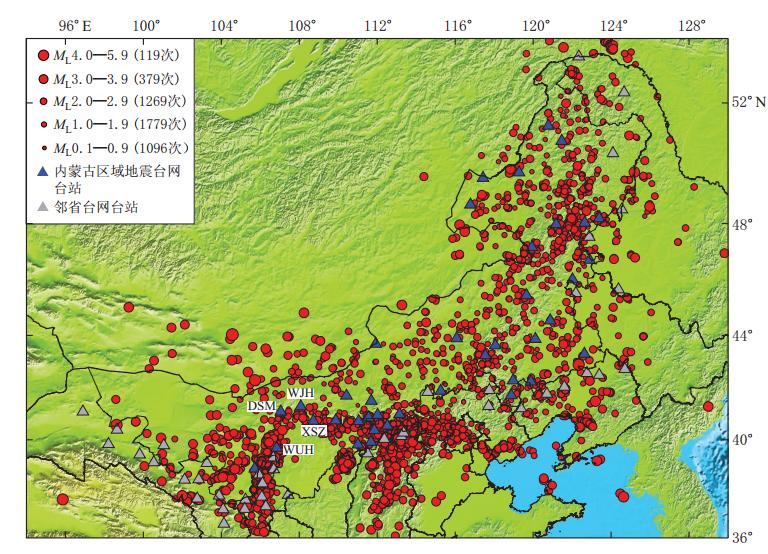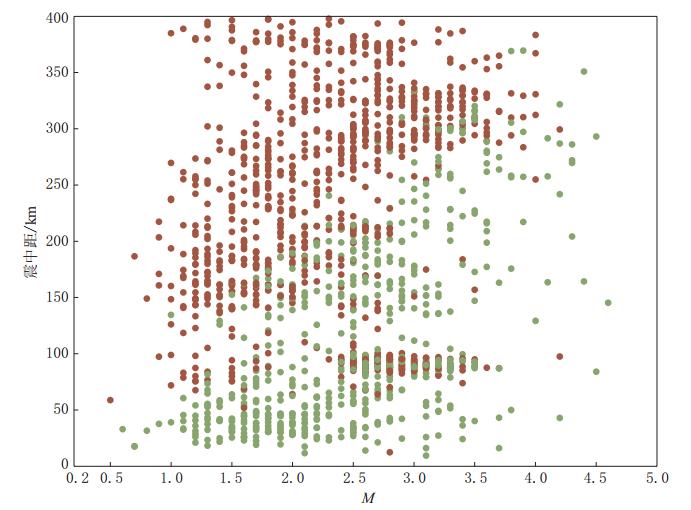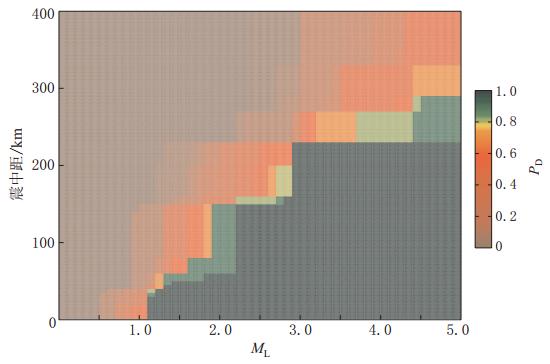A study on detection capability of the Inner Mongolia regional seismic network
-
摘要: 国际上新近发展的“基于概率的完整性震级”(PMC)方法,具有可考察地震定位中由于台站人为选择等造成的台网监测能力下降,以及避免传统基于G-R关系的统计算法因地震数目过少而无法评估等优点.本研究利用PMC方法,计算得到内蒙古区域地震台网39个台站对周边地震事件的检测概率及台网检测概率.单台检测概率结果显示:PMC方法能够客观地反映39个台站对地震事件的检测能力;因台网布局等影响,内蒙古区域地震台网中西部和中东部地区的台站检测能力较强,而靠近蒙古、俄罗斯边境的台站, 阿拉善右旗附近地区的台站,以及邻近吉林、黑龙江等地区的台站检测能力较低.合成检测概率结果显示,由于邻省台站的引入,全区80%的地区基于概率的最小完整性震级MP达到2.2左右,其余地区MP达到3.3左右.为提高地震台网监测能力,建议在监测能力较弱的中蒙交界地区、东北部地区,以及阿拉善左旗以西地区适度加密台站,进一步优化台网布局.
-
关键词:
- 内蒙古区域地震台网 /
- 最小完整性震级 /
- 基于概率的完整性震级方法
Abstract: As a new developed method for estimating earthquake detection probabilities, the probability-based magnitude of completeness (PMC) method can avoid decreasing the detection capability resulted by artificial factors, and can access the detection capability in the areas where traditional Gutenberg-Richter relationship-based method is ineffective due to lack of earthquakes. In this study, we determine the detection probability of all 39 stations of the Inner Mongolia seismic network by using the PMC method. The results show that the PMC method can reflect the network earthquake monitoring capacity objectively. The detection probability is better than other regions in the midwestern and the mid-eastern region of Inner Mongolia, due to better coverage of seismic stations, however, it is poor in the Alxa Youqi region, the Sino-Russian border, and Sino-Mongolia border. Synthesized detection probability results indicate that minimum probability-based magnitude of completeness, MP, can reach ML2.2 in the 80% area of the Inner Mongolia when the stations of the neighboring networks are involved, and only about ML3.3 in other areas. In order to enhance the monitoring capacity of Inner Mongolia regional seismic network, more stations are still needed to emplace in the Sino-Mongolia border region, the northeastern region of Inner Mongolia, and to the west of Alxa Zuoqi to optimize the layout of seismic network. -
-
图 4 2009年1月6日内蒙古磴口 ML1.8地震和4个记录台站的检测概率图中各子图分别给出了DSM,WJH,WUH和XSZ台的检测概率以及波形记录情况,其中波形进行了0.5 Hz的高通滤波,图中白色方块标出了地震在相应的震中距和震级所对应的检测概率
Figure 4. Detection probabilities and seismograms of the Dengkou,Inner Mongolia,ML1.8 earthquake on 6 January 2009 The insets contain detection probability distributions of four selected stations(DSM,WJH,WUH and XSZ). Small white squares mark the detection probability of each station for this particular event,given by its magnitude and respective distance to the stations. Seismograms filtered through 0.5 Hz high-pass filter are shown as overlays in white frames
表 1 内蒙古区域地震台网台站检测概率PD统计表
Table 1 Detection probability,PD,of the stations of the Inner Mongolia regional seismic network

表 2 内蒙古区域地震台网不同区域的台站检测概率统计表
Table 2 Statistical results of the regional detection probability of the stations of the Inner Mongolia regional seismic network

-
郭飙, 刘启元, 陈九辉, 李顺成. 2002. 首都圈数字地震台网的微震定位实验[J]. 地震地质, 24(3): 453-460. Guo B, Liu Q Y, Chen J H, Li S C. 2002. Test of epicenter determination of micro earthquakes recorded by the digital seismic network in capital circle[J]. Seismology and Geology, 24(3): 453-460 (in Chinese).
蒋长胜, 吴忠良. 2005. 由"重复地震"给出的中国地震台网的定位精度估计[J]. 中国地震, 21(2): 147-154. Jiang C S, Wu Z L. 2005. Estimating the location accuracy of the China National Seismograph Network using repeating events[J]. Earthquake Research in China, 21(2): 147-154 (in Chinese).
蒋长胜, 吴忠良, 李宇彤. 2008. 首都圈地区"重复地震事件"及其在区域地震台网定位精度评价中的应用[J]. 地球物理学报, 51(3): 817-827. Jiang C S, Wu Z L, Li Y T. 2008. Estimating the location accuracy of the Beijing Capital Digital Seismograph Network using repeating events[J]. Chinese Journal of Geophysics, 51(3): 817-827 (in Chinese).
吴开统, 焦远碧, 杨满栋. 1991. 中国地震台网布局的优化方案[J]. 地震学刊, (1): 22-37. Wu K T, Jiao Y B, Yang M D. 1991. An optimum scheme for distribution of seismic station networks in China[J]. Journal of Seismology, (1): 22-37 (in Chinese).
中国地震局监测预报司. 2003. 数字地震观测技术[M]. 北京: 地震出版社: 521-522. Department of Monitoring and Prediction, China Earthquake Administration. 2003. Digital Seismic Observation Technique[M]. Beijing: Seismological Press: 521-522 (in Chinese).
Amorèse D. 2007. Applying a change-point detection method on frequency-magnitude distributions[J]. Bull Seismol Soc Am, 97(5): 1742-1749.
Bartal Y, Somer Z, Leonard G, Steinberg D M, Horin Y B. 2000. Optimal seismic networks in Israel in the context of the Comprehensive Test Ban Treaty[J]. Bull Seismol Soc Am, 90(1): 151-165.
Cao A M, Gao S S. 2002. Temporal variation of seismic b-values beneath northeastern Japan island arc[J]. Geophys Res Lett, 29(9): 1334. doi:10.1029/2001GL013775.
Doufexopoulou M, Korakitis R. 1992. Resolution analysis of seismic networks[J]. Phys Earth Planet Inter, 75(1/2/3): 121-129.
Enescu B, Ito K. 2002. Spatial analysis of the frequency-magnitude distribution and decay rate of aftershock activity of the 2000 Western Tottori earthquake[J]. Earth Planets Space, 54(8): 847-859.
Gentili S, Sugan M, Peruzza L, Schorlemmer D. 2011. Probabilistic completeness assessment of the past 30 years of seismic monitoring in northeastern Italy[J]. Phys Earth Planet Inter, 186(1/2): 81-96.
Gomberg J, Reasenberg P, Bodin P, Harris R. 2001. Earthquake triggering by seismic waves following the Landers and Hector Mine earthquakes[J]. Nature, 411(6836): 462-466.
Gutenberg R, Richter C F. 1944. Frequency of earthquakes in California[J]. Bull Seismol Soc Am, 34(4): 185-188.
Knopoff L. 2000. The magnitude distribution of declustered earthquakes in Southern California[J]. Proc Natl Acad Sci USA, 97(22): 11880-11884.
Main I. 2000. Apparent breaks in scaling in the earthquake cumulative frequency-magnitude distribution: Fact or artifact?[J]. Bull Seismol Soc Am, 90(1): 86-97.
Marsan D. 2003. Triggering of seismicity at short timescales following Californian earthquakes[J]. J Geophys Res, 108(B5): 2266. doi:10.1029/2002JB001946.
Mignan A, Werner M J, Wiemer S, Chen C C, Wu Y M. 2011. Bayesian estimation of the spatially varying completeness magnitude of earthquake catalogs[J]. Bull Seismol Soc Am, 101(3): 1371-1385.
Mignan A, Jiang C S, Zechar J D, Wiemer S, Wu Z, Huang Z B. 2013. Completeness of the mainland China earthquake catalog and implications for the setup of the China Earthquake Forecast Testing Center[J]. Bull Seismol Soc Am, 103(2A): 845-859.
Nanjo K Z, Schorlemmer D, Woessner J, Wiemer S, Giardini D. 2010. Earthquake detection capability of the Swiss Seismic Network[J]. Geophys J Int, 181(3): 1713-1724.
Plenkers K, Schorlemmer D, Kwiatek G, JAUARS Research Group. 2011. On the probability of detecting picoseismicity[J]. Bull Seismol Soc Am, 101(6): 2579-2591.
Rabinowitz N, Steinberg D K. 1990. Optimal configuration of a seismographic network: A statistical approach[J]. Bull Seismol Soc Am, 80(1): 187-196.
Schaff D P, Richards P G. 2004. Repeating seismic events in China[J]. Science, 303(5661): 1176-1178.
Schorlemmer D, Woessner J. 2008. Probability of detecting an earthquake[J]. Bull Seismol Soc Am, 98(5): 2103-2117.
Schorlemmer D, Mele F, Marzocchi W. 2010. A completeness analysis of the national seismic network of Italy[J]. J Geophys Res, 115(B4): B04308. doi:10.1029/2008JB006097.
Stein R S. 1999. The role of stress transfer in earthquake occurrence[J]. Nature, 402(6762): 605-609.
Wiemer S, Wyss M. 2000. Minimum magnitude of complete reporting in earthquake catalogs: Examples from Alaska, the Western United States, and Japan[J]. Bull Seismol Soc Am, 90(4): 859-869.
Wiemer S, Wyss M. 2002. Mapping spatial variability of the frequency-magnitude distribution of earthquakes[J]. Adv Geophys, 45(Ⅰ/Ⅱ/Ⅲ/Ⅳ/Ⅴ): 259-302.
Woessner J, Hauksson E, Wiemer S, Neukomm S. 2004. The 1997 Kagoshima (Japan) earthquake doublet: A quantitative analysis of aftershock rate changes[J]. Geophys Res Lett, 31(3): L03605. doi:10.1029/2003/GL018858.
Woessner J, Wiemer S. 2005. Assessing the quality of earthquake catalogs: Estimating the magnitude of completeness and its uncertainties[J]. Bull Seismol Soc Am, 95(4): 684-698.
Wüster J, Rivière F, Crusem R, Plantet J, Massinon B, Caristan Y. 2000. GSETT-3: Evaluation of the detection and location capabilities of an experimental global seismic monitoring system[J]. Bull Seismol Soc Am, 90(1): 166-186.





 下载:
下载:




